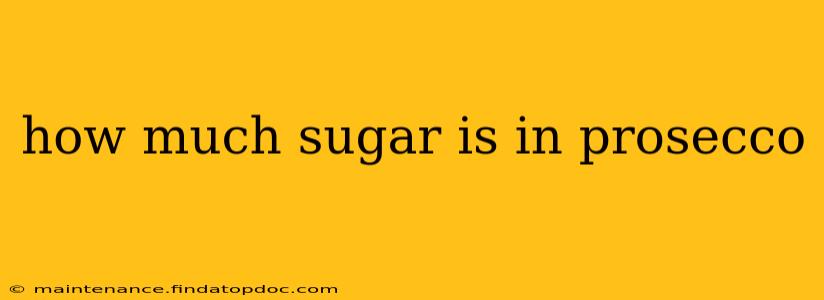How Much Sugar is in Prosecco? Uncorking the Sweetness
Prosecco, the beloved Italian sparkling wine, is known for its refreshing bubbles and fruity notes. But how much sugar does it actually contain? The answer isn't a simple number, as the sweetness level varies significantly depending on the type of Prosecco. Let's delve into the details and uncover the truth about sugar in Prosecco.
What are the different types of Prosecco and their sugar levels?
Prosecco's sweetness is determined by its sugar content, categorized by the European Union's labeling system:
-
Brut: This is the driest style of Prosecco, containing between 0-12 grams of sugar per liter. Many consider this the classic style, emphasizing the wine's crisp acidity and fruitiness.
-
Extra Dry: Slightly sweeter than Brut, this style typically contains between 12-17 grams of sugar per liter. It retains some dryness but offers a gentler sweetness that appeals to a broader range of palates.
-
Dry: This category typically contains 17-32 grams of sugar per liter. It's noticeably sweeter than Extra Dry, offering a more pronounced sweetness that balances the acidity.
-
Demi-Sec: This is a semi-sweet style, containing between 32-50 grams of sugar per liter. It offers a clear sweetness, more akin to dessert wines. This style is less common in Prosecco.
-
Sweet: This is the sweetest classification, containing more than 50 grams of sugar per liter. It's the least common type of Prosecco you're likely to encounter.
It's crucial to check the label carefully, as the specific sugar content isn't always explicitly stated but the sweetness classification (Brut, Extra Dry, etc.) will provide a good indication.
Does the sweetness of Prosecco affect its calories?
Yes, the sugar content directly impacts the calorie count. Sweeter Proseccos like Demi-Sec and Sweet will naturally contain more calories than drier styles like Brut. While a standard serving (approximately 150ml) of Prosecco generally falls within the 100-120 calorie range, sweeter variations can add extra calories. For those watching their calorie intake, opting for a Brut Prosecco is generally a better choice.
How can I tell how much sugar is in a specific bottle of Prosecco?
Unfortunately, the exact sugar content in grams per liter isn't always clearly displayed on the label. However, the sweetness classification (Brut, Extra Dry, Dry, etc.) offers a good guide. If you're looking for precise measurements, you might need to consult the winery's website or contact the producer directly. Pay attention to the small print and look for details like "residual sugar" listed in grams/liter or g/L.
What is the difference between Prosecco and other sparkling wines in terms of sugar?
Prosecco's sweetness profile overlaps with other sparkling wines, but the range and typical styles differ. Champagne, for example, tends to emphasize drier styles, with Brut being the most common. Other sparkling wines from regions like Cava (Spain) or Crémant (France) also have various sweetness levels, reflecting local preferences and production methods. The key takeaway is to always check the label for the sweetness classification to understand the sugar content.
Is there a "healthiest" type of Prosecco in terms of sugar?
From a sugar perspective, the Brut Prosecco is the healthiest choice, boasting the lowest sugar content. However, moderation is key, regardless of the type you choose, as all alcoholic beverages should be consumed responsibly.
In conclusion, the amount of sugar in Prosecco varies greatly. Understanding the different sweetness classifications—Brut, Extra Dry, Dry, Demi-Sec, and Sweet—helps you make informed choices based on your preferences and dietary needs. Remember to always check the label for the most accurate information.
